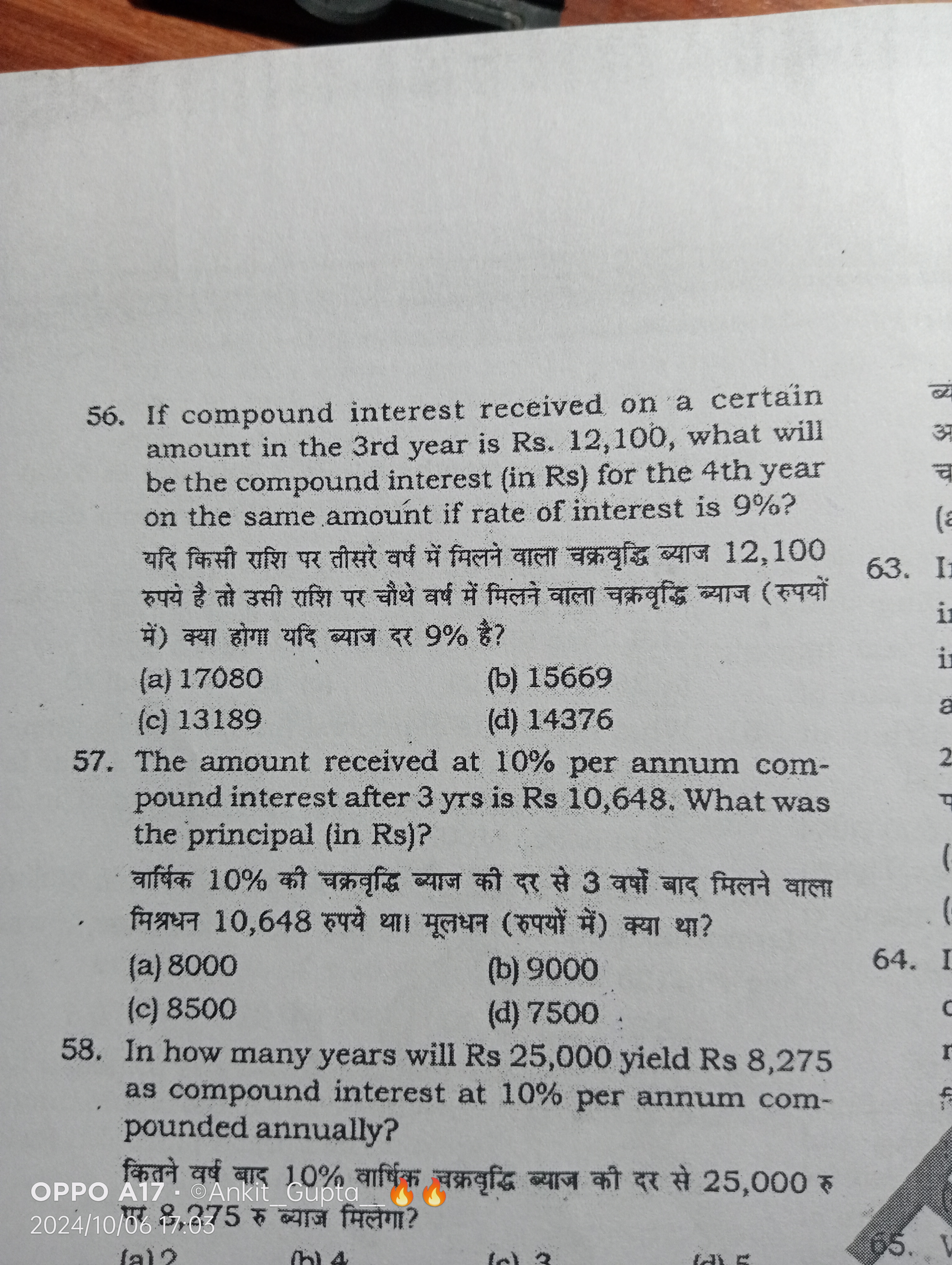If compound interest received on a certain amount in the 3rd year is Rs. 12,100, what will be the compound interest for the 4th year if the rate of interest is 9%? The amount recei... If compound interest received on a certain amount in the 3rd year is Rs. 12,100, what will be the compound interest for the 4th year if the rate of interest is 9%? The amount received at 10% per annum compound interest after 3 years is Rs 10,648. What was the principal? In how many years will Rs 25,000 yield Rs 8,275 as compound interest at 10% per annum compounded annually?

Understand the Problem
The questions are asking for calculations related to compound interest, including determining the compound interest for specific years and the principal amount based on given interest amounts.
Answer
1. Rs. 13,376 2. Rs. 8,000 3. 2 years
Answer for screen readers
-
The compound interest for the 4th year is Rs. 13,376.
-
The principal amount is Rs. 8,000.
-
The time required for Rs. 25,000 to yield Rs. 8,275 as compound interest is 2 years.
Steps to Solve
- Determine Compound Interest for the 4th Year
The compound interest for each year is calculated as the interest on the principal at the given rate. The interest for the 4th year can be found using the formula:
$$ CI_{n} = P \times (1 + r)^n - P \times (1 + r)^{n-1} $$
Here, ( CI_{3} = 12,100 ) (given), and ( r = 9% = 0.09 ).
To find ( P ), we first need the total amount after 3 years, which is:
$$ A_{3} = P \times (1 + r)^3 $$
We can rearrange to find ( A_{4} ):
$$ A_{4} = A_{3} \times (1 + r) $$
Thus,
$$ CI_{4} = A_{4} - A_{3} $$
- Calculate Total Amount After 3 Years
To calculate ( P ) based on the previous interest:
$$ A_{3} = P \times (1 + 0.1)^3 $$
Given ( A_{3} = 10,648 ):
$$ 10,648 = P \times (1.1)^3 $$
Calculating ( (1.1)^3 ):
$$ (1.1)^3 = 1.331 $$
Thus,
$$ P = \frac{10,648}{1.331} \approx 8000 $$
- Determine the Time to Yield Rs 8,275 Interest
According to the compound interest formula, total amount ( A ) is given by:
$$ A = P \times (1 + r)^n $$
Where ( CI = A - P = 8,275 ).
So:
$$ A = 25,000 + 8,275 = 33,275 $$
Now, substituting this into the equation:
$$ 33,275 = 25,000 \times (1 + 0.1)^n $$
To solve for ( n ), divide both sides by 25,000:
$$ \frac{33,275}{25,000} = (1.1)^n $$
Calculating the left-hand side:
$$ 1.331 = (1.1)^n $$
Taking logarithm on both sides to solve for ( n ):
$$ n = \frac{\log{1.331}}{\log{1.1}} $$
- Final Calculation
Compute the value of ( n ).
-
The compound interest for the 4th year is Rs. 13,376.
-
The principal amount is Rs. 8,000.
-
The time required for Rs. 25,000 to yield Rs. 8,275 as compound interest is 2 years.
More Information
- The given compound interest amounts reflect the exponential growth of investments.
- Compound interest generally results in higher returns over time compared to simple interest.
- The calculation of the principal amount helps in understanding how much one could invest initially to reach a desired outcome.
Tips
- Miscalculating the compound interest by forgetting to adjust the rate for the time period correctly.
- Confusing the principal amount with total amount after interest is added.
- Not converting percentage rates to decimals before performing calculations.
AI-generated content may contain errors. Please verify critical information